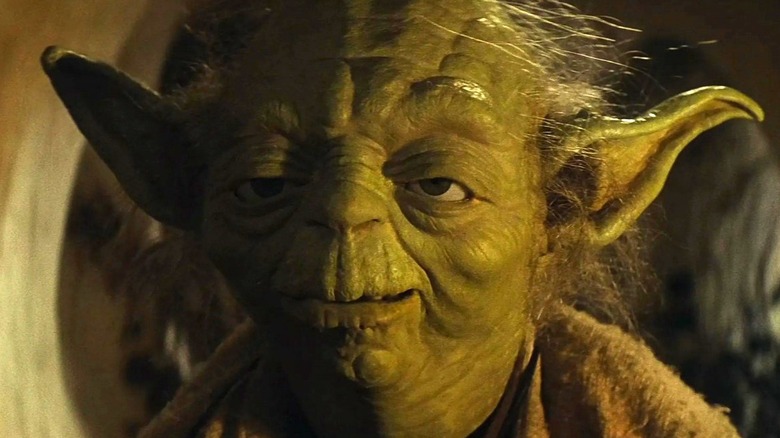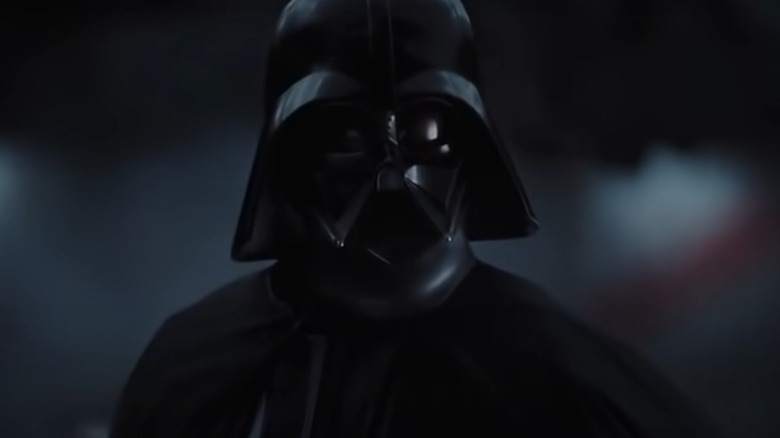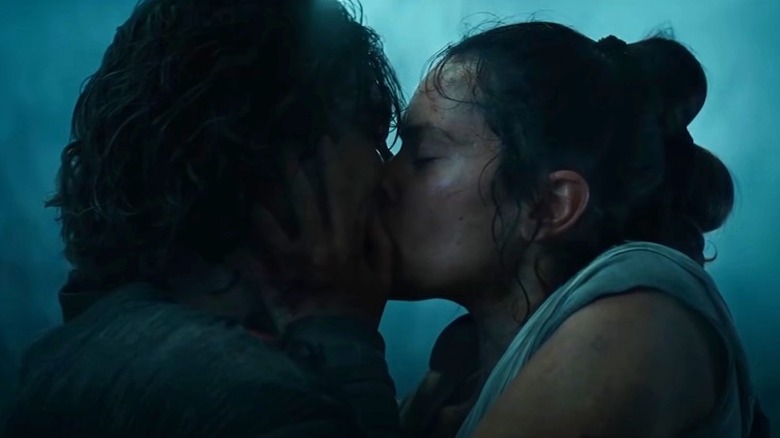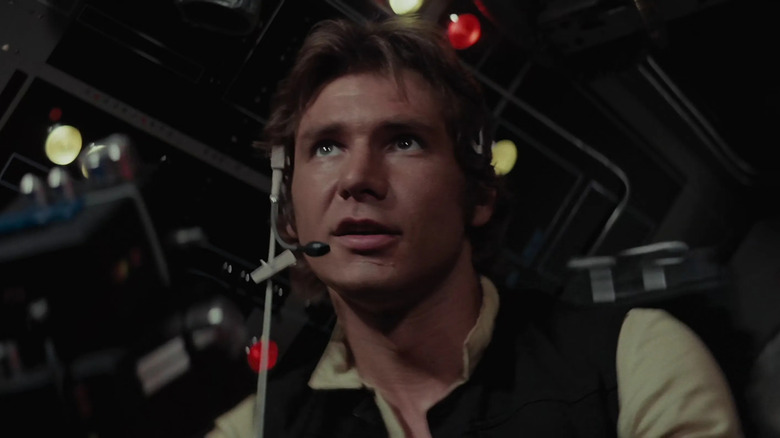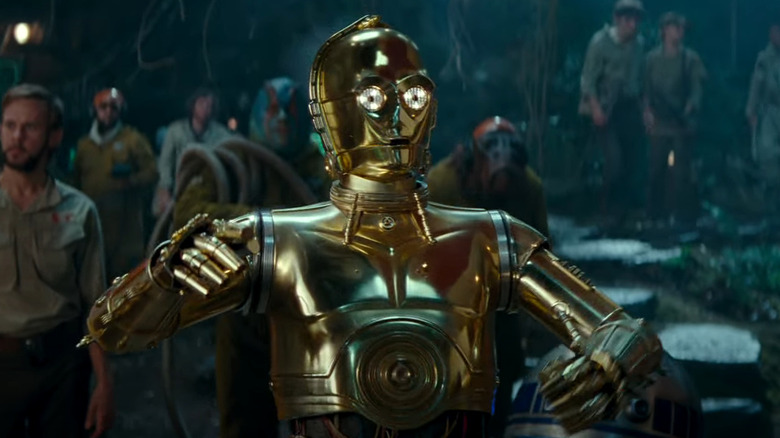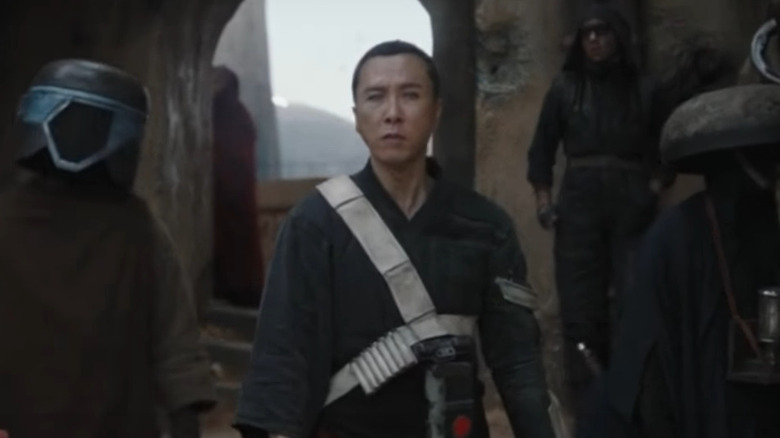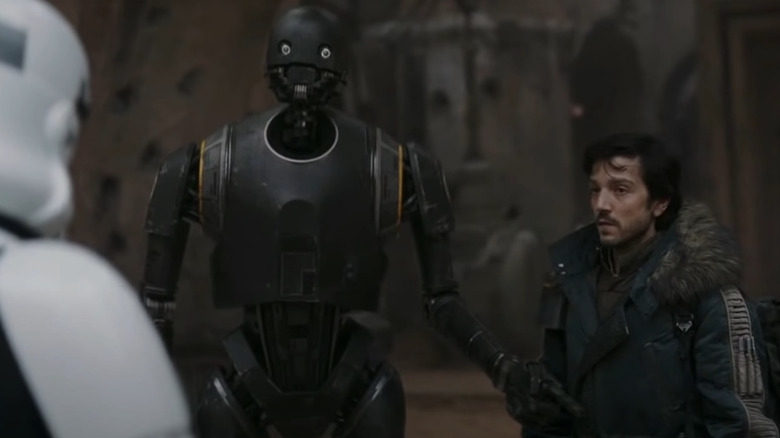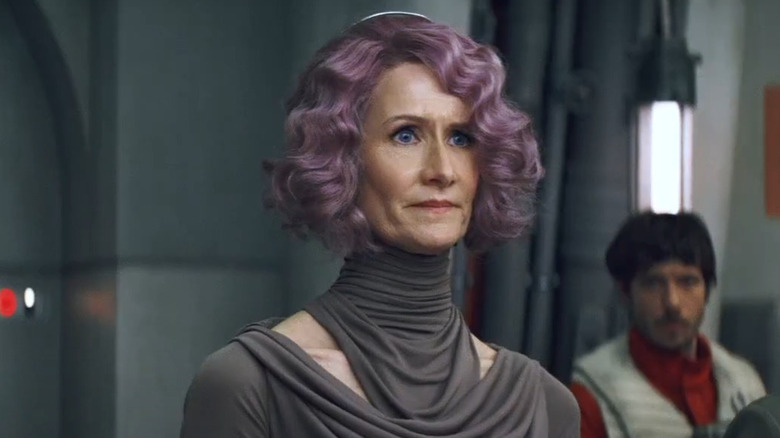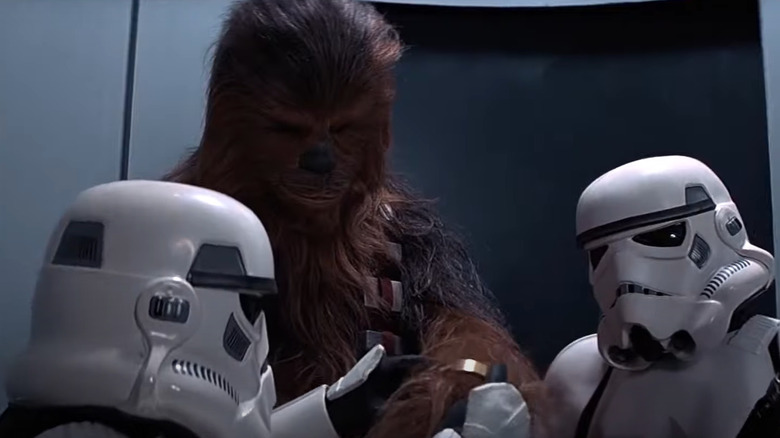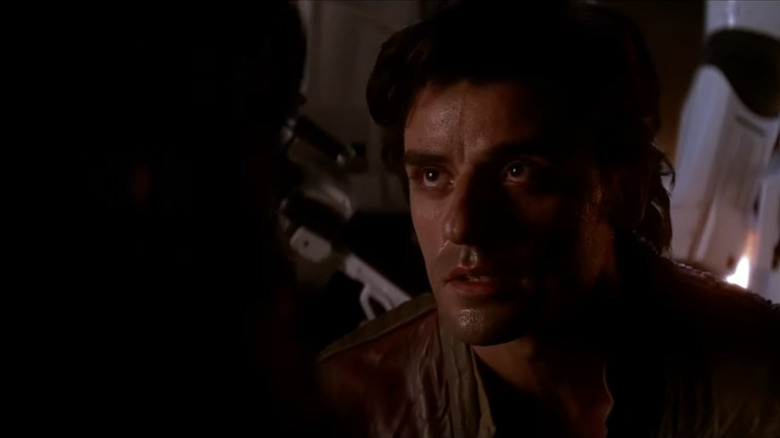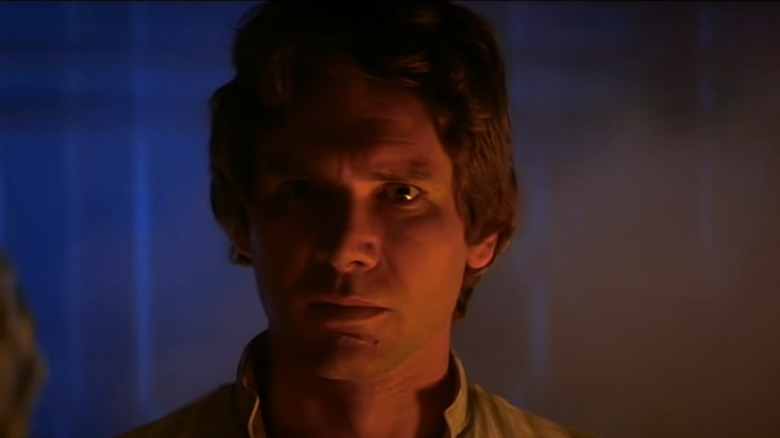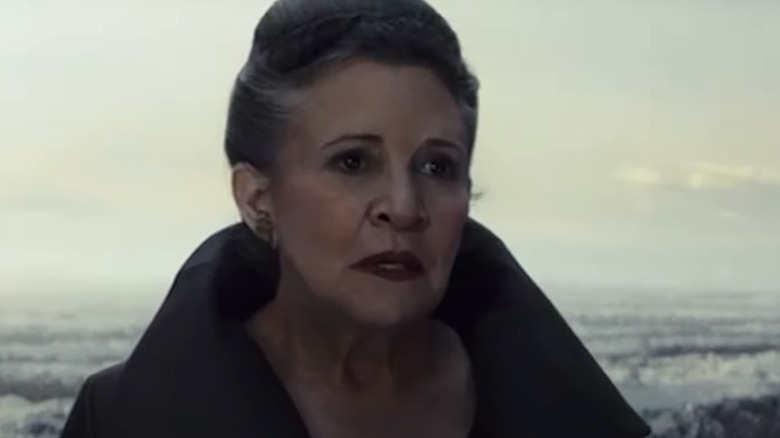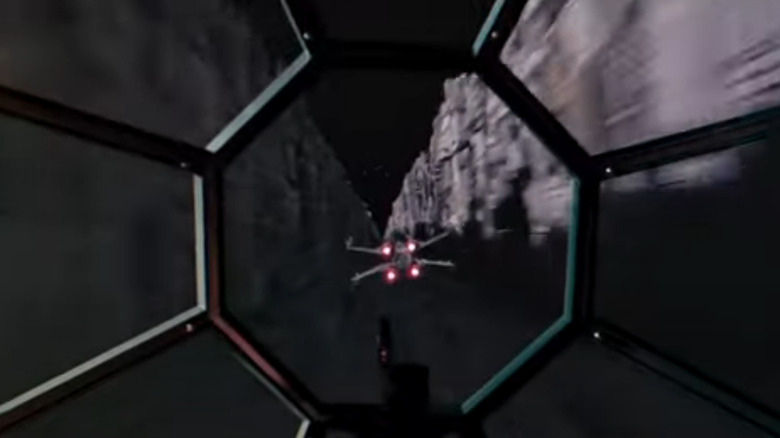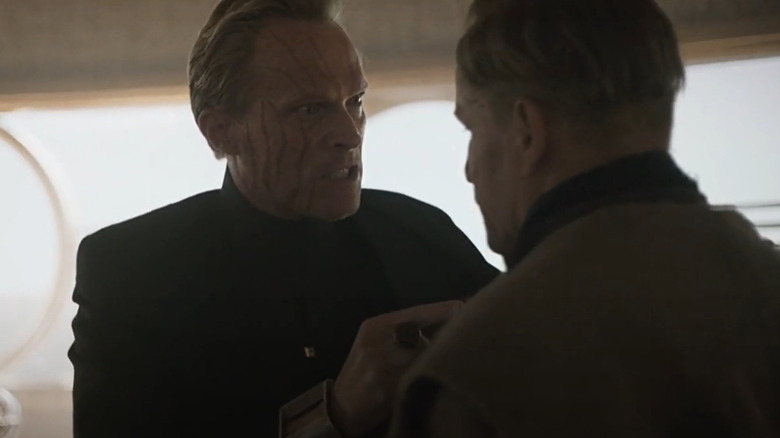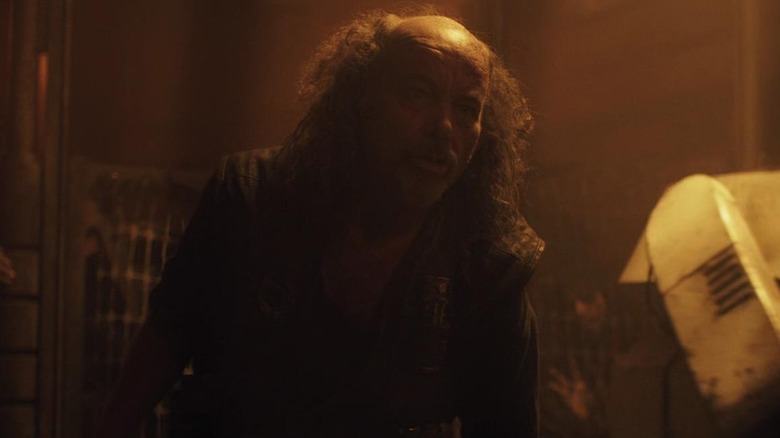Star Wars Movie Scenes That Were Never Supposed To Happen
With a franchise box office currently totaling the multi-billions, it's no secret that "Star Wars" is one of the biggest movie series of all time. The franchise's dollar value stands as quantifiable proof that the series is and will remain an iconic pop culture touchstone for generations to come. However, not all of the moments that have become iconic, memorable, and endearing were planned from the start.
In fact, some of the most recognizable character beats and lines of dialogue in "Star Wars" were completely improvised, while others were entirely accidental. Most folks would probably guess that creating the blockbuster franchise, which basically paved the way for every other blockbuster franchise, is no easy feat. Given the immense success of "Star Wars," it is interesting to consider how many of its stand-out moments were the results of fluidity instead of a rigid adherence to the filmmakers' best-laid plans.
So join us as we travel back to movie sets and editing rooms a long time ago and far, far away to take a look at all of the "Star Wars" movie scenes that were never supposed to happen.
Vader gets scary again
At the end of 2016's "Rogue One," director Gareth Edwards took about a minute of screen time to remind everybody why the galaxy was so afraid of Darth Vader. Edwards channels all of his monster movie energy — the man directed 2014's "Godzilla" — to depict Vader as a horror villain in a slasher movie. It's absolutely iconic, and it even made a list of the best lightsaber fights published by The Washington Post. Given how outstanding the scene is, many fans may be surprised to learn it was never intended to be included in the movie.
In an interview with Yahoo! News, "Rogue One" editor Dan Gilroy said the scene was added during reshoots of the film. Gilroy explained the scene was never in the original cut of the movie and that while some of Vader's other scenes got the axe, none of them featured as much action as what ended up in theaters. Sometimes, reshoots can ruin movies and possibly even spell doom for a movie's box performance. However, it's safe to say that Vader's hallway rampage may be one of the greatest late additions to any movie ever.
Reylo on the big screen
The 2019 film "The Rise of Skywalker" was divisive, to say the least. The movie left long-time franchise fans so split that director J.J. Abrams even weighed in on the controversy surrounding the film following its premiere in an interview with Vanity Fair. Even though the movie left some fans wanting more, it did manage to pay off some pretty well-seeded storylines before its climax. One of these moments — a steamy kiss between lead protagonists Ben Solo (aka Kylo Ren) and Rey Skywalker (who is revealed to be Emperor Palpatine's granddaughter) — almost never made it on screen.
In a conversation with author Sariah Wilson, actress Daisy Ridley revealed her character's kiss with Ben Solo was one of two versions of the scene captured during the shoot (via Heavy.) During her conversation with Wilson, Ridley explained the initial scene included in an early cut didn't include the intimate moment between the story's leads. However, Abrams decided to include it later, much to Ridley's own expressed delight. The scene also served as pay off to fans who shipped "Reylo" since their first meeting in the "Star Wars: Force Awakens." Whether viewers went into the film specifically rooting for the character connection or not, it's hard to deny the emotional heights reached by the two Jedi's embrace on the big screen.
Han shot (some lines) first
Harrison Ford is best known for his iconic action heroes, such as Indiana Jones and Han Solo. However, his talents on set go far beyond simply being cool in front of the camera. It turns out Ford is also a strong improviser. On an episode of the Russo Brother's Podcast, "Pizza Film School," Mark Hamill praised Ford's ability to ad-lib on set.
Hamill explained that the actors working on "Star Wars: A New Hope" were all motivated to make the best movie they could make. In an effort to contribute, many "Star Wars" stars brought ideas forward to George on set. Hamill specifically cited an ad-lib from Ford during the dog fight between the Millennium Falcon and some Tie Fighters as an example, explaining that Ford made up Solo's "Don't get cocky kid" line on the spot. It's a small moment, but it perfectly aligns with Solo's grizzled characterization.
Luckily for fans everywhere, actors like Ford injected their own interpretation of Lucas' characters throughout the original production. Creating an earth-shattering franchise is no easy feat, but stories like these show Lucas got help from his actors even if he didn't specifically ask for it.
The quick wink goodbye
When "Star Wars: The Last Jedi" was released in 2017, it delivered several long-awaited reunions between fan-favorite characters. However, one subtle display of emotion between two lifelong companions almost never made it to the bring screen.
During the film's climax, the villainous First Order entraps the Resistance within an abandoned base on the planet Crait. Just when all hope seems lost, the reclusive Jedi Master Luke Skywalker shows up to save the day. When Luke arrives, fans witness his brief reunion with his sister, Princess Leia, and his old friend C-3PO. However, in an interview with "Entertainment Tonight," actor Mark Hamill revealed it was his idea to wink at C-3PO. He explained that the script didn't include a goodbye between Luke and his long-time companion, so the actor asked Rian Johnson if the characters could share a moment on screen. Johnson agreed, but there wasn't much time. So, in lieu of an extra scene, Hamill delivered an unscripted wink during the shoot to the beloved droid.
Not having any interaction between Skywalker and C-3PO would have been a bad decision, but luckily for fans across the galaxy, Hamill showed up ready to pay Luke's long-time pal some respect.
Sight gags
In 2016, Donnie Yen's blind spiritual warrior Chirrut Imwe stole the show in "Rogue One." Yen's blend of humor, kung-fu, and faith in the Force made Imwe an immediate fan favorite. However, Imwe's blindness — arguably his most unique character trait — wasn't written into the original script. In fact, Yen came up with the idea himself while preparing for the role.
In a video interview with Movies Ireland during a press tour for the film, Yen explained he pitched Imwe's blindness to "Rogue One" director Gareth Evans because he felt the intended version of the character was a little too cliche. Yen proposed that the character's lack of sight would give him greater insight into the Force because without vision, Imwe would greatly rely on his intuition and other senses.
Yen also explains he felt playing the role with humor would be another way to differentiate Imwe from the run-of-the-mill stoic monk archetype. For example, when Imwe is captured on Jedha and his captors place a sack over his head, he famously quips, "Are you kidding me? I'm blind!" Moments of levity like these humanize the mysterious monk to the audience. Given just how popular Imwe is with fans, it's interesting to consider that he was almost a completely different character. It's a good thing Mr. Yen spoke up on set.
A 'fresh one' and a fresh line
Chirrut Imwe wasn't the only "Rogue One" character with jokes and improvisation. In fact, he may not even be the funniest member of the team. Most fans would probably put that honor or Alan Tudyk's robot K-2SO. Tudyk — a long-time character actor with a resume that runs from "Resident Alien" to the "Firefly" series — brings a perfect sardonic tone of voice to all of K-2SO's line readings. It's a very, very funny performance, and one of the funniest moments was the result of onset improvisation from Tudyk.
When K-2SO tries to sneak his companion Cassian Andor past Stormtroopers, the robot slaps his fake prisoner when he senses the Stormtroopers are on to his ruse. In an interview with "Entertainment Tonight," Alan Tudyk explained the physical slap was Andor actor Diego Luna's idea. Tudyk went on to say that the following line, "And there's a fresh one if you mouth off again," was his addition. Humor is often the result of spontaneity, so it's no surprise that an actor's improv created one of the movie's biggest laughs. It's also a great showcase of just how much diverse talent it takes to make a crowd-pleaser like "Rogue One."
A fond farewell
Carrie Fisher's death in 2016 was a sad loss for "Star Wars" fans everywhere. It also made her final few appearances in the remaining "Star Wars" movies all the more poignant, especially her goodbye scenes. One of those scenes focused on the last conversation between Laura Dern's Admiral Holdo and Fisher's iconic Princess Leia. It's a short conversation that's made all the more moving because it's shared between two different generations of female franchise stars. Interestingly, the scene wasn't in the original script.
In an interview with the Los Angeles Times, director Rian Johnson confirmed he wrote the farewell scene with each actor on set. He went on to explain that Dern wanted to use the scene as a means to say thanks to Fisher "for what Leia meant to her growing up." He also added that Fisher came up with Leia's final words to Holdo. When the women both attempt to say, "let the Force be with you," it was Fisher's idea for Leia to respond, "I've said it enough, you go ahead." It's a good thing Rian listened to his actors, or else the scene may not have turned out to be the nice tribute it became. It's a beautiful scene that serves as a quiet salute to a remarkable talent like Fisher and an inspirational character like Leia.
Helmet heads
After forty-plus years, Mark Hamill confirmed one of Luke Skywalker's funnier beats in the original "Star Wars" was a piece of improvised dialogue. In "Star Wars: A New Hope" Luke and Han mount a rescue mission to save Princess Leia from imprisonment on the Death Star. To move through the Imperial space station undetected, Luke and Han steal uniforms from two unsuspecting Storm Troopers.
When the men don the Stormtrooper outfits, Luke immediately grumbles, "I can't see a thing in this helmet!" The line was not in the original script, and Hamill confirmed on Twitter he improvised the line on set because he really couldn't see out of his costume. Hamill goes on to say everybody liked the ad-lib, so director George Lucas let him keeping using the line during takes.
While humor may not have been at the top of Lucas's list when developing the original "Star Wars," it's hard to deny little moments like these give the series its lasting charm. It's a credit to actors, directors, and costume designers alike that some of the series' most memorable moments were born out of what famous painter Bob Ross would call, "happy little accidents."
Who talks first
When "The Force Awakens" was released in 2015, Oscar Isaac's pilot Poe Dameron became a fan-favorite character almost immediately. His on-screen charisma, sarcasm, and cocky demeanor made him a strong stand-out early in the movie's runtime. However, Isaac's pilot almost didn't make it through the entire film.
In fact, in the original script, Poe dies after being captured by the First Order in the opening act. In an iO9 clip, director J.J. Abrams says the initial plan had been to kill Poe off. But Isaac didn't want to portray another character who died early in a film, so Abrams reworked the story to keep Poe alive.
In an interview with Rolling Stone, Isaac explained that the reworked story with reshoots gave him a lot of leeway to improvise lines on set. These reshoots are likely why some of Poe's scenes feel much looser than anything else in the film. In the interview, Isaac specifically cites his first meeting with Kylo Ren. While his character was always intended to confront Ren after being captured, Isaac improvised the scene's humor with lines like "So who talks first? You talk first?" These types of beats from the actor helped make Poe a fan-favorite character.
The fly by the seat of your pants energy that Isaac brings to the movie is both in line with his character and the means of the movie's production. Isaac jokingly described the reshoots as "making s*** up as we go" — Poe would approve.
I know
If "Star Wars: A New Hope" kicked off the high concept blockbuster movement, then "Star Wars: The Empire Strikes Back" solidified the staying power of the franchise. While "The Empire Strikes Back" is probably best known for the line associated with its famous twist, the second most recognizable line from the film wasn't included in the script. After being captured by the Empire in Cloud City, Han is sentenced to be frozen in carbonite. Before the punishment is carried out, Leia looks at Han and admits her feelings for him when she says, "I love you." Han, famously, replies, "I know."
However, "I know" wasn't in the original screenplay. According to Vulture, The line was created in a conversation between Harrison Ford and director Irvin Kershner. Initially, the script called for a longer response from Han, but Ford felt that "I know" would be truer to the film's character. Given the line's recognizability, it's clear Ford was on to something when he cooked it up. Plus, Lucas liked the improv so much that he included the line in the next film, "Star Wars: Return of the Jedi," but reversed the roles. There, Han tells Leia he loves her, to which Leia responds, "I know."
It can be hard to pin down exactly why some franchises become a global phenomenon and others fail to make an impact at the box office. However, iconic moments like "I know" act as pretty clear signposts of success.
Carrie Fisher the writer
One of the most anticipated moments in "Star Wars: The Last Jedi" was the reunion between separated siblings Luke and Leia. When the pair finally reconnect, the moment is tender, funny, and mindful of the lasting legacy of the franchise. It's a great payoff for fans who have been waiting to see the Skywalkers together again. The scene's success lies at the feet of its talented actors, especially considering that Fisher and Hamill had portrayed Leia and Luke since 1977. Given their histories with the characters, it should be no surprise that both actors had a hand in writing some of the scene's dialogue.
Fisher, in particular, added the line to her brother about her changing hairstyles. Director Rian Johnson confirmed in an interview with People that the "I changed my hair" line was entirely Fisher's creation. It's a testament to Fisher's talents as a writer that she could create dialogue that referenced her own character's legacy that simultaneously manages to sound like a natural joke between a brother and sister. May the Force be with you, Ms. Fisher.
In the creative trenches
The Death Star is one of the most recognizable pieces of movie iconography ever committed to the silver screen. With its world-shattering beam, turret-lined trenches, and endless floors of baddies, the Death Star is an all-time great movie creation. However, one of its most distinctive features — the trench — was only added as the result of an accident.
During a Reddit AMA, Colin Cantwell, the concept artist and spacecraft designer for "A New Hope," explained that the trenches were born out of a molding mistake. When Cantwell was building the Death Star model, the mold's separate halves shrunk where they should have seamlessly met in the middle. The shrinkage created a trench-like effect on the surface of the Death Star. Cantwell didn't want to take the time necessary to fix the mistake, so he pitched the trench design to Lucas, and the rest is history.
It's a good thing Cantwell and Lucas opted to keep the trenches. The climactic trench run is a truly classic scene, and their aesthetic relation to World War 2 films creates another connection between "Star Wars" and the Saturday morning serials that inspired Lucas in the first place.
Swapping Vos
Like its central hero, the production of "Solo: A Star Wars Story" has a troubled backstory. Originally intended to be directed by duo Christopher Miller and Phil Lord (who found success with comedy adventures like "The Lego Movie"), production took a left turn when the two men were fired and replaced by Ron Howard. One of the biggest changes to the movie following the directors' departure was its villain.
Originally, Miller and Lord cast the late Michael K. Williams as the film's villain. However, when Howard came on board to do reshoots, Williams' schedule didn't permit him to come back for additional work. Since Williams couldn't appear for reshoots, his role was recast. Actor Paul Bettany replaced Williams and put his own spin on the part. In an interview with The GATE, Bettany says he feels Vos is essentially "a businessman." This thinking may explain why Bettany plays Vos like a sociopathic middle manager. His performance makes Vos' threats toward the heroes seem almost polite — even though his presence is so discomforting.
While Bettany's performance as Dryden Vos is solid, it's too bad fans didn't get to see William's take on the big bad. William's ability to play eccentric characters — like Omar Little on "The Wire" — with grounded, real-world emotion elevates most projects he appears in. While fans may never know what Williams' might have looked like in the "Star Wars" universe, it's a testament to the late actor's fantastic abilities that he's so sorely missed.
Ron's re-do
While Dryden Vos' recasting may have been the biggest single change Howard made to the film, he also made a slew of smaller changes and additions. In fact, reports indicate around 80 percent of the movie is the result of reshoots. In a video interview with Collider, Howard addressed questions about reshoots saying "it was a rewrite and a continuation," and Howard's team was very "targeted" in its efforts.
While it's hard to know exactly what Howard reshot and what he kept from Christopher Miller and Phil Lord's initial work, Howard has insisted that Lord's and Miller's "fingerprints" remain all over the final product (via Collider). One element fans are sure is a Howard add is the casting of his brother Clint Howard in the film.
Clint plays the "mean man" who confronts droid L3-37 during the bar scene when the Solo first meets Lando Calrissian. Ron casts his character actor brother in many of his movies, to the point where Clint's appearances have become something of a calling card for Ron. Clint's addition may not be as significant a change as a major character recasting or an altered plot point, but it is a good example of a director's influence over a given project. Considering "Solo" switched directors over halfway through its production, it's safe to assume Howard's finished project is much different than what Miller and Lord started.
